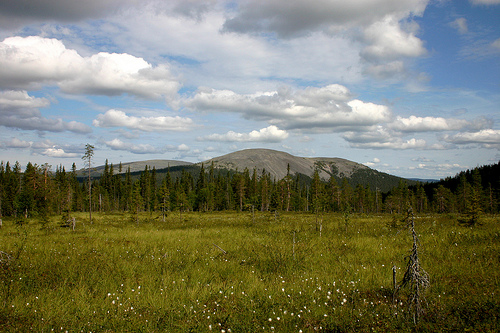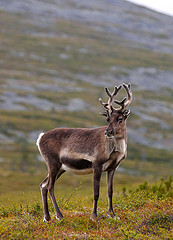

Location: Lapland Map
Area: 1,020 km²
Official site

Pallas-Yllastunturi National Park is located in Lapland region of Finland. It covers a total area of 1020 square km. Pallas-Yllastunturi National Park is one of the most visited parks in the region with over 300,000 tourists visiting the nature reserve annually. Most of the visitors come to Pallas-Yllastunturi National Park in the summer during warm months of the season. Although winter times also draws many to cross county skiing and snowmobiling among patches of forests. This national park covers an area of 1,020 km² from merging of Pallas-Ounastunturi National Park and Yllas-Aakenus Nature Reserve. Reindeer husbandry is still commonly seen here as well as numerous herds of these beautiful animals.
Hiking opportunities
Pallas-Yllästunturi
National Park has dozens of different hiking and skiing trails that
are suitable for hikers of all levels. Along the routes you can see
the nature of the national park in many ways. Some of the routes
take you to the tops of the fells, and some introduce the area's
forest nature and bog landscapes.
In the national park, you
can move with muscle power e.g. walking, mountain biking, kayaking,
skiing and snowshoeing. Versatile hiking trails offer the
possibility of day trips of various lengths as well as longer hikes.
In Pallas-Yllästunturi National Park, day hikers also have the
opportunity to climb to the tops of the fells. Popular day trips
include the Pyhäkero day trip, the Taivaskero tour, the Pirunkuru
effort, the Varkaankuru trail, the Kesänkijärvi tour and the
Tuomikuru tour.
The majority of the routes are ring routes,
and there are maintained rest areas along all routes. Huts, sheds,
campfire sites, landscape sites, and desert and reserve huts serve
as resting places. There are a total of 340 kilometers of marked
summer hiking trails in the national park. In addition, there are a
total of about 200 kilometers of summer hiking trails in the
vicinity of the national park. Mountain biking is allowed on marked
summer hiking trails with a few exceptions. There are more than 500
kilometers of ski trails and more than 100 kilometers of winter
hiking trails. It is possible to walk on winter hiking trails,
snowshoeing and mountain biking.
The best-known of the
national park's hiking trails is the Hetta-Pallas hiking trail,
which is the oldest marked hiking trail in Finland. The route was
lined in 1934. The approximately 50-kilometer-long Hetta-Pallas
hiking trail can be hiked in either direction. The route runs
through mountain plateaus and gorges. The hiking trail takes you to
the top of several fells. There are several serviced desert and
reservation huts along the route.
Geography and nature
The
landscape of Pallas-Yllästunturi National Park is dominated by a
mountain range that is a remnant of an ancient fold. The current
circular fells are worn base parts of the corrugated mountains. The
highest point of the national park is the Pallastunturi Taivaskero,
which peaks at 809 meters above sea level. Other high peaks include
Pyhäkero, Lumikero, Bag, and Payroll. Kero means a woodless round
mountain law.
The nature of Pallas-Yllästunturi National Park
is diverse and varied. There are several different habitats in the
area: bogs, cloth forests, natural old-growth forests, open fells
and groves.
Vegetation and water bodies
The national park
is rich in vegetation. Among the tree species in the area, pine,
spruce and mountain birch are particularly popular. Typical plants
for woodless fell areas are various low-growing plants such as
birch, uuvana, ryegrass and crowberry. In the lush creek groves you
can find, among other things, Lapland red currant, eagle wing, dill
and nectar. In the cloth forests, blueberry and lingonberry thrive
on sparrow plants. In the old moist evergreen forests, the woodcock
and the grasshopper grow, as well as many rare species of moss and
fungi.
The bogs are a typical landscape of
Pallas-Yllästunturi National Park in addition to the fells and
coniferous forests. Many wetland plants such as marsh wool, tufted
wool, hilla and lily of the valley thrive in the swamp. Rare palms,
for example, also grow in calcareous areas.
The national park
has several lakes and ponds as well as streams. The largest lake in
the park is Pallasjärvi, which is located southeast of the
Pallastunturi Nature Center.
Large mammals found in the
national park include reindeer and deer. Reindeer in particular
thrive in the fells and marshes during the summer. Typical mammals
also include hare, fox, woodpecker, mountain onion, various mole
species and squirrel. Bears and lynxes live permanently in the
Pallas-Yllästunturi National Park area.
In
Pallas-Yllästunturi National Park, northern and southern bird
species meet. Northern species include Kiruna, partridge and
partridge. Lush grove-like spruces are preferred for southern
species such as blackbird and chirp. In the forest, for example,
various species of tiacs, loons and common urns thrive. When there
are plenty of moles, more owls and hawks can also be spotted in the
area. The typical inhabitant of the streams is the rapids, which
dive for their food from the flowing water even in winter. Other
bird species observed in the national park include the blue-breasted
lizard, the lizard, the yellow wagtail, the swamp and the blackbird.
Weather and natural phenomena
The location of
Pallas-Yllästunturi National Park, north of the Arctic Circle,
brings with it typical weather and natural phenomena related to
seasonal variations. Winter includes camouflage in December-January,
snowfall, frosts up to -30 ºC and little sunlight. In the evenings
and at night, celestial bodies and northern lights can be observed
from the cloudless sky.
The snow cover is at its thickest in
the national park in March-April, when there may be more than a
meter of snow in the fells and forests. In spring and winter, the
amount of light increases rapidly. In the spring, the snow melts and
the amount of light continues to increase. Summer begins in
mid-June, and in June-July the area is illuminated by the midnight
sun. During a nightless night, the sun does not set below the
horizon.
The autumn season usually begins in the fells of
Western Lapland in mid-September and lasts two to three weeks. The
first snow will fall on the area after mid-October, but occasional
snow showers are also found in the summer months, especially in the
Pallas-Ounastunturi area.
Responsibility
Pallas-Yllästunturi National Park has been awarded the European
Charter 1 certificate 2013-2018 and 2019-2023. The certificate has
been issued by the European Association of Protected Areas EUROPARC.
All national parks in Finland follow the principles of
litter-free hiking. The goal of litter-free hiking is for walkers to
take care of their own rubbish off the terrain and deliver it to
serviced ecopoints. The aim is to reduce the amount of waste that
ends up in nature.
For waste sorting, the Pallastunturi,
Tunturi-Lapland and Yllästunturi Nature Centers have ecopoints to
which paper, cardboard, glass and metal waste and batteries can be
delivered. Biowaste can be composted in dry toilets and small
amounts of combustible debris can be incinerated at fire sites.
In Pallas-Yllästunturi National Park, air purity is measured at
the Finnish Meteorological Institute's Sammaltunturi measuring
station. According to a WHO bulletin, the measuring station in
Sammaltunturi is one of the places where the cleanest air in the
world is measured. There, small particle concentrations are less
than 4 µg / m3.
Nature centers
Pallas-Yllästunturi
National Park has three nature centers: Yllästunturi Nature Center
Kellokas, Pallastunturi Nature Center and Tunturi-Lapland Nature
Center in Hetta. The nature advisors ’customer advisors talk about
the national park and hiking opportunities. The nature centers Meän
elämää, From Forest to Bare and Vuovjjuš - Kulkijat exhibitions
present the nature and culture of the area. It is also possible to
watch movies and art exhibitions in the nature centers. In addition,
visitors can buy nature-themed products.
History
The idea
of establishing national parks in Finland was first presented as
early as 1910. At that time, the Protected Forestry Committee
proposed in its report the establishment of national parks on
Pallastunturi and Pyhätunturi in Pelkosenniemi. For his part, the
Finnish botanist Kaarlo Linkola strongly influenced the
establishment of a national park in the Pallastunturi area.
The proposal for a general nature reserve to be established in
Pallas-Ounastunturi was approved by the 1928 Parliament, and finally
in 1938, after several reports and presentations, Finland's first
national parks were established. Among the first was
Pallas-Ounastunturi National Park.
In the area of
Pallas-Yllästunturi National Park, the history of tourism dates
back to the 1930s, when mountain skiing courses were started at
Ounastunturi Pyhäkero and Pallastunturi. Tourism also became more
common in Äkäslompolo at the same time.
The national park has
been known by its current name since 2005, when the Ylläs-Aakenus
conservation area was annexed to Pallas-Ounastunturi National Park.
The highest peak of Yllästunturi and the ski resorts located on it
do not belong to the area of the national park, but the ski resort
on Pallastunturi Laukukero belongs.